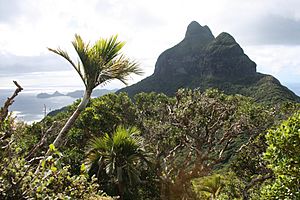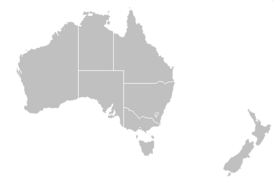Mount Lidgbird facts for kids
Quick facts for kids Mount Lidgbird |
|
|---|---|
| Mount Ledgbird; Big Hill | |

Mount Lidgbird photographed from the summit of Mount Gower
|
|
| Highest point | |
| Elevation | 777 m (2,549 ft) |
| Geography | |
| Location | Lord Howe Island, New South Wales, Australia |
| Geology | |
| Mountain type | Volcanic |
Mount Lidgbird is a tall mountain on Lord Howe Island in Australia. It is also known as Mount Ledgbird or Big Hill. This mountain stands 777 meters (about 2,549 feet) above sea level. It is located in the southern part of the island, just north of Mount Gower. A dip in the land called a saddle separates Mount Lidgbird from Mount Gower.
Climbing to the top of Mount Lidgbird is very difficult. It is only for experienced climbers because of its steep and slippery cliffs. Ropes are needed to get to the summit. In contrast, climbing Mount Gower is much easier.
About halfway up Mount Lidgbird, there is a place called Goat House Cave. In the 1800s, people who gathered Kentia palm trees used this cave as a shelter. Today, visitors to Goat House Cave can see many interesting birds. These include masked boobies and red-tailed tropicbirds nesting there.

Why is it Called Mount Lidgbird?
Mount Lidgbird was named by a naval officer named Captain Henry Lidgbird Ball. He named the mountain to honor his father, George Lidgbird Ball. Captain Ball was the first European to see Lord Howe Island in 1788. He was on his way to Norfolk Island aboard his ship, the HMS Supply. He also named a nearby rock formation called Ball's Pyramid.
Plants on the Mountain
Mount Lidgbird is home to special kinds of forests. One type is the Cryptocarya forest. You can find patches of this forest on the mountain slopes. They grow at heights between 350 and 600 meters (about 1,150 to 1,970 feet) above sea level. This is one of two main forest types on Lord Howe Island; the other is a palm forest.
Several types of palm trees also grow on Mount Lidgbird. These include the Hedyscepe and Lepidorrhachis palm species.


